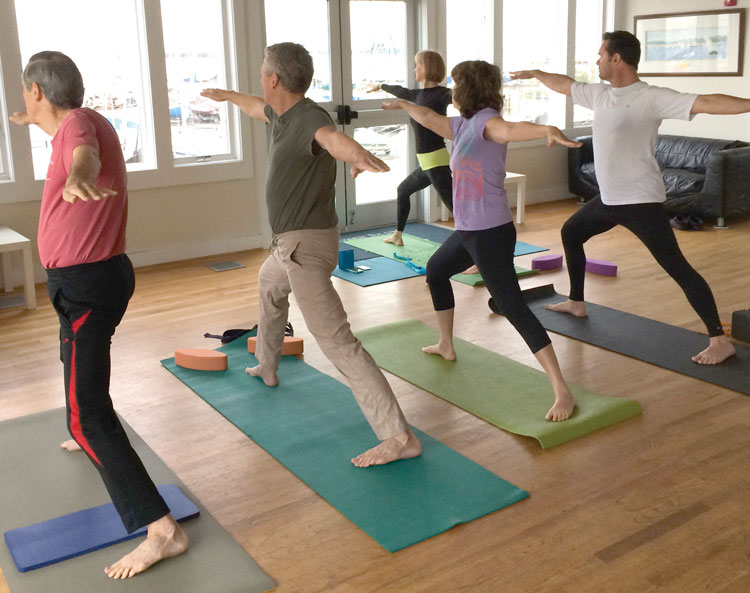Sailing is a sport that demands a lot of short-burst anaerobic exercise, coupled with concentration, agility, and focus. Even the “driver” typically experiences fatigue in the arms, back, feet, and ankles after a long day on the water. While most racers (and some cruisers) put in time at the gym lifting weights and doing cardio to maintain their competitive edge, flexibility training often goes overlooked. That’s where yoga comes into play.

Yoga is a year-round tool for increasing balance, strength, and flexibility. It can be done at home, in an office, a hotel room, on the dock, or even the deck of your boat. All you need is a mat and enough room to lie flat. If you can do a push-up in the space, you can do yoga.
Gavin O’Hare, author of the Contemporary Team Racing manual and a former sailing coach at the Naval Academy, uses yoga to combat the aging process. “Yoga keeps me limber, which really helps with my performance and recovery,” he affirms.
Depending upon the type of yoga you are doing, the practice might be a fast flow or a slower series with longer holds. Yoga is generally considered to be an isometric activity because the poses are static. This gives your body a chance to tap into all the smaller muscles that aren’t given much attention in traditional gym routines.
Kathleen Schuman, owner and teacher at Prana Yoga Studio in Annapolis, observes that sailors do a lot of pulling and don’t counteract with much pushing. Schuman recommends shoulder openers, chest openers and, of course, core work to stabilize the torso.
SpinSheet senior editor, J/22 sailor, and yoga instructor, Duffy Perkins, points out that yoga builds body awareness. “You become more mindful about what is causing pain and how you can adjust your movements to alleviate pressure on affected muscles and joints.”
While most yoga poses, or asanas, can be done as stand-alone exercises, experts recommend a complete practice to reap the full benefits. A typical routine begins with some breath work, or pranayama, followed by gentle stretching to loosen up the connective tissues. As you progress through the practice, more movement is introduced in the form of standing poses, planks, and balance postures.
Keith Carew of Farr Yacht Designs, and a regular on the sport boat circuit, discovered yoga after back surgery in June 2016. Carew embraces the physical benefits of a regular practice. “Yoga utilizes the same stretches I was doing in physical therapy, and it helps with my balance.”
Becoming a yogi, or yoga practitioner, can definitely improve your range of motion, but it doesn’t happen overnight. It’s important to remember that yoga requires persistence. Just as lifting weights in the gym won’t create strength after only one or two workouts, opening tight shoulders and hamstrings takes time. That’s why it’s called a yoga practice.
Bonnie Urban, a J/70 sailor and yoga instructor with a background in occupational therapy, notes the overlap between standard yoga poses and the exercises prescribed by physical therapists. “If you look at the ‘stretch deck’ used in physical therapy, you’ll see the same movements yogis have been doing for thousands of years.”
Yoga also builds concentration skills by training the mind to shut out distractions and focus on the present. The mindfulness encouraged by yoga cultivates mental strength and stamina. Learning how to stay in the moment and breathe through discomfort is a valuable skill whether you’re sitting on the rail in an icy drizzle, or jockeying for position on a crowded starting line.
Urban recalls teaching a group of Severn Sailing Association juniors who were preparing for a competition. The air was abuzz with nerves, so she started off with some breathing exercises. Then she had her students visualize their starting sequence as she took them through a series of high lunges, called warrior poses.
Making analogies between the stance and what they would be doing on the course, Urban recited the following routine: “Warrior I, you face forward with arms overhead. You’re in the boat, you’re looking around to assess the conditions. Warrior II, you rotate your hips and torso, and extend your arms. You’re dialed in, and going for the line. Warrior III, you tip forward and shift your weight onto your standing leg. Now you’re racing, and you’re going for speed and heading for the mark.”
While she can’t attest to whether the routine helped her students’ performance on the course, Urban saw them start to lighten up and have fun. The lesson is to keep an open mind and realize that you’ll get out of yoga what you put into it.
Jessica Sunder, who teaches independently and at YogaWorks in Severna Park, MD, stresses the importance of enjoying the journey. “Investigate different teachers and styles to find what resonates,” she advises.
Whatever type of yoga you try, leave adequate time for savasana, or corpse pose, at the end of your practice. Lying prone and taking a moment to relax at the end of your session gives your central nervous system a chance to integrate and seal in the work you’ve done, whether it’s improving balance and posture, building core strength, or just clearing your mind with movement.
by Leslie Toussaint




